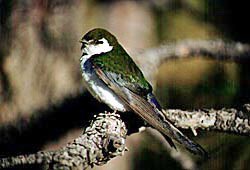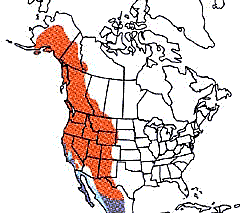|
Common Name (preferred): Violet-green Swallow Scientific Name: Tachycienta thalassina Size (weight, length & wingspan) English & Metric: Weight—49oz (14g), Length—5.25" (13cm), Wingspan—13.5" (34 cm) Habitat: Variety of woodland habitats Diet: Insects Predators: Falcons
General Biology: Swallows are slender-bodied birds with long, pointed wings. They are adept aerialists, darting and diving to catch flying insects. 
NPS The Violet-green Swallow is found west of the Rockies. It is bright metallic green on its back with purple at the base of its neck and above its tail and solid white below. It is distinguished from the Tree Swallow by the white patches above its eye and on its rump. The Violet-green Swallow can be seen in a variety of woodland habitats. It nests in hollow trees or rock crevices and often forms loose colonies. Behavior: The Violet-green Swallow is a cavity nester and builds its nest of grass and weeds, lined with feathers. The nest will either be built by the male and female as a team or by the female alone. They will aggressively defend their nest from other cavity nesters. Four to six eggs are usually laid and will hatch after 13-14 days. Conservation: 
NPS Violet-green Swallows are also known to go into a hibernation-like state of inactivity called torpor. During unseasonably cold and cloudy weather, they may not be able to find enough insects to maintain their energetic lifestyle, so to conserve energy, they become dormant. If you encounter a swallow that appears to be only semiconscious, the best thing you can do is to leave it alone. If the bird is in a location where it might be injured or disturbed by a careless visitor, carefully move it (gently pushing an index finger into its chest until it steps up on to your finger--in the same manner you would a parakeet or other pet bird) to a safer spot where it can warm up in the sun. In a few hours it will become fully alert and resume its fast-paced lifestyle. When and where to see at Bryce: Further Reading: Erlich, Paul R. et al. 1988. The Birder's Handbook: a field guide to the natural history of North American Birds, Simon and Schuster/Fireside Books, New York Ryser, Fred A. 1985. Birds of the Great Basin: A Natural History. University of Nevada Press Sibley, David Allen. 2001. The Sibley Guide to Bird Life and Behavior. Knopf Publishing |
Last updated: June 2, 2022
